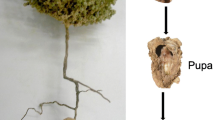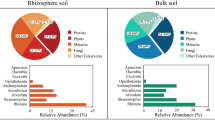Abstract
The aim was to study the effects of P fertilization and leaf aphid attack on the trophic interactions of bacteria and bacterial feeders in the rhizospheres of barley plants. The density of protozoa peaked in the rhizospheres of plants fertilized with N and P, whereas nematodes peaked in the rhizospheres of plants to which only N had been added. Fingerprinting of bacterial communities by length heterogeneity polymerase chain reaction revealed differences in community structure between NP rhizospheres and N rhizospheres as well as aphid-related differences within N rhizospheres. Specifically, α-proteobacteria increased with P addition. To evaluate if differences in bacteria in terms of their quality as food could partly explain the observed differences in protozoan and nematode abundances, growth of the flagellate Cercomonas sp. was assessed with 935 bacteria isolated from the different treatments. This assay indicated that bacterial isolates were of higher food quality to Cercomonas sp. in NP than in N rhizospheres when plants were subjected to aphid attack. Bacteria of high and low food quality for Cercomonas sp., respectively, were fed to the nematode Caenorhabditis elegans and larval production examined. α-Proteobacteria supported the growth of Cercomonas sp. well, whereas Actinobacteria did not. In contrast, C. elegans reproduced poorly on most α-proteobacteria but were able to reproduce well on some Actinobacteria. These results suggest that the different response of protozoa and nematodes to P addition could be mediated through a food quality-related change in community composition of bacteria and that leaf aphid attack may interfere with nutrient effects on bacterial assemblages of rhizospheres.




Similar content being viewed by others
References
Andersen KS, Winding A (2004) Non-target effects of biological control agents on soil Protozoa. Biol Fertil Soils 40:230–236
Bååth E, Olsson S, Tunlid A (1988) Growth of bacteria in rhizoplane and rhizosphere of rape seedlings. FEMS Microbiol Ecol 53:355–360
Christensen H, Griffiths B, Christensen S (1992) Bacterial incorporation of tritiated thymidine and populations of bacteriophagous fauna in the rhizosphere of wheat. Soil Biol Biochem 24:703–709
Da Silva P, Nahas E (2002) Bacterial diversity in soil in response to different plants, phosphate fertilizers and liming. Braz J Microbiol 33:304–310
De Boer W, Gunnewiek PJAK, Kowalchuk GA, van Veen JA (2001) Growth of chitinolytic dune soil β-subclass Proteobacteria in response to invading fungal hyphae. Appl Environ Microbiol 67:3358–3362
Djigal D, Sy M, Brauman A, Diop TA, Mountport D, Chotte JL, Villenave C (2004) Interactions between Zeldia punctata (Cephalobidae) and bacteria in the presence or absence of maize plants. Plant Soil 262:33–44
Ekelund F, Rønn R, Griffiths BS (2001) Quantitative estimation of flagellate community structure and diversity in soil samples. Protist 152:301–314
Elliott ML, Guartal EA, des Jardin EA, Skipper HD (2003) Effect of nitrogen rate and root-zone mix on rhizosphere bacterial populations and root mass in creeping bentgrass putting greens. Biol Fertil Soils 37:348–354
Griffiths BS, Young IM, Boag B (1991) Nematodes associated with the rhizosphere of barley (Hordeum vulgare). Pedobiologia 35:265–272
Hahn MW, Höfle MG (2001) Grazing of protozoa and its effect on populations of aquatic bacteria. FEMS Microbiol Ecol 35:113–121
Hallmann J, Rodríguez-Kábana R, Kloepper JW (1999) Chitin-mediated changes in the bacterial communities of the soil, rhizosphere and within roots of cotton in relation to nematode control. Soil Biol Biochem 31:551–560
Höflich G, Tauschke M, Kühn G, Rogasik J (2000) Influence of agricultural crops and fertilization on microbial activity and microorganisms in the rhizosphere. J Agron Crop Sci 184:49–54
Holland JN, Cheng W, Crossley DA (1996) Herbivore-induced changes in plant carbon allocation: assessment of below-ground fluxes using carbon-14. Oecologia 107:87–94
Inunza V, Alström S, Eriksson KB (2002) Root bacteria from nematicidal plants and their biocontrol potential against trichodorid nematodes in potato. Plant Soil 241:271–278
Liljeroth E, Schelling GC, Van Veen JA (1990) Influence of different application rates of nitrogen to soil on rhizosphere bacteria. Neth J Agric Sci 38:255–264
Liu WT, Marsh TL, Cheng H, Forney LJ (1997) Characterization of microbial diversity by determining terminal restriction fragment length polymorphisms of genes encoding 16S rRNA. Appl Environ Microbiol 63:4516–4522
Marschner P, Crowley D, Yang CH (2004) Development of specific rhizosphere bacterial communities in relation to plant species, nutrition and soil type. Plant Soil 261:199–208
McCaig AE, Glover LA, Prosser JI (2001) Numerical analysis of grassland bacterial community structure under different land management regimens by using 16S ribosomal DNA sequence data and denaturing gradient gel electrophoresis banding patterns. Appl Environ Microbiol 67:4554–4559
Mercer CF, Greenwood DR, Grant JL (1992) Effect of plant and microbial chitinases on the eggs and juveniles of Meloidogyne hapla Chitwood. Nematologica 8:227–236
Munn EA, Munn PD (2002) Feeding and digestion. In: Lee DL (ed) The biology of nematodes. Taylor & Francis, Singapore, pp 211–232
Newsham KK, Rolf J, Pearce DA, Strachan RJ (2004) Differing preferences of Antarctic soil nematodes for microbial prey. Eur J Soil Biol 40:1–8
Olsen RA, Bakken LR (1987) Viability of soil bacteria: optimization of plate-counting technique and comparison between total counts and plate counts within different size groups. Microb Ecol 13:59–74
Page FC (1976) An illustrated key to freshwater and soil amoeba. Freshwater Biological Association, Ampleside
Ridder-Duine AS, Kowalchuk GA, Paulien JA, Gunnewiek K, Smant W, van Veen JA, de Boer W (2005) Rhizosphere bacterial community composition in natural stands of Carex arenaria (sand sedge) is determined by bulk soil community composition. Soil Biol Biochem 37:349–357
Ritchie NJ, Schuter ME, Dick RP, Myrold DD(2000). Use of length heterogeneity PCR and fatty acid methyl ester profiles to characterize microbial communities in soil. Appl Environ Microbiol 66:1668–1675
Rønn R, Ekelund F, Christensen S (1995) Optimizing soil extract and broth media for MPN-enumeration of naked amoebae and heterotrophic flagellates in soil. Pedobiologia 39:10–19
Rønn R, Grunert J, Ekelund F (2001) Protozoan response to addition of the bacteria Mycobacterium chlorophenolicum and Pseudomonas chlororaphis to soil microcosms. Biol Fertil Soils 33:126–131
Rønn R, McCaig AE, Griffiths BS, Prosser JI (2002) Impact of protozoan grazing on bacterial community structure in soil microcosms. Appl Environ Microbiol 68:6094–6105
Rovira AD, Newman EI, Bowen HJ, Cambell R (1974) Quantitative assessment of the rhizoplane microflora by direct microscopy. Soil Biol Biochem 6:211–216
Techau MEC, Bjørnlund L, Christensen S (2004) Simulated herbivory effects on rhizosphere organisms in pea (Pisum sativum) depended on phosphate. Plant Soil 264:184–194
Torsvik V, Sørheim R, Goksøyr J (1996) Total bacterial diversity in soil and sediment communities—a review. J Ind Microbiol 17:170–178
Venette RC, Ferris H (1998) Influence of bacterial type and density on population growth of bacterial-feeding nematodes. Soil Biol Biochem 30:949–960
Vestergård M (2004) Nematode assemblages in the rhizosphere of spring barley (Hordeum vulgare L.) depended on fertilisation and plant growth phase. Pedobiologia 48:257–265
Vestergård M, Bjørnlund L, Christensen S (2004) Aphid effects on rhizosphere microorganisms and microfauna depend more on barley growth phase than on soil fertilization. Oecologia 141:84–93
Wamberg C, Christensen S, Jakobsen I (2003) Interaction between foliar-feeding insects, mycorrhizal fungi, and rhizosphere protozoa on pea plants. Pedobiologia 47:281–287
Weekers PHH, Bodelier PLE, Wijen JPH, Vogels GD (1993) Effects of grazing by the free-living soil amoebae Acanthamoeba castellanii, Acanthamoeba polyphaga, and Hartmannella vermiformis on various bacteria. Appl Environ Microbiol 59:2317–2319
Wilmotte A, Vanderauwera G, Dewachter R (1993) Structure of the 16S ribosomal-RNA of the thermophilic cyanobacterium Chlorogloeopsis HTF (‘Mastigocladus laminosus HTF’) strain PCC7518, and phylogenetic analysis. FEBS Lett 317:96–100
Zhang Z, Yuen GY, Sarath G, Penheiter AR (2001) Chitinases from the plant disease biocontrol agent, Stenotrophomonas maltophilia C3. Phytopathology 91:204–211
Acknowledgements
The C. elegans (N2) was kindly supplied by the Caenorhabditis Genetics Center at the University of Minnesota. Lisa Bjørnlund was supported by a grant from the Danish Veterinary and Agricultural Research Council. Regin Rønn was supported by a grant from the Danish Natural Sciences Research Council.
Author information
Authors and Affiliations
Corresponding author
Rights and permissions
About this article
Cite this article
Bjørnlund, L., Mørk, S., Vestergård, M. et al. Trophic interactions between rhizosphere bacteria and bacterial feeders influenced by phosphate and aphids in barley. Biol Fertil Soils 43, 1–11 (2006). https://doi.org/10.1007/s00374-005-0052-7
Received:
Revised:
Accepted:
Published:
Issue Date:
DOI: https://doi.org/10.1007/s00374-005-0052-7




